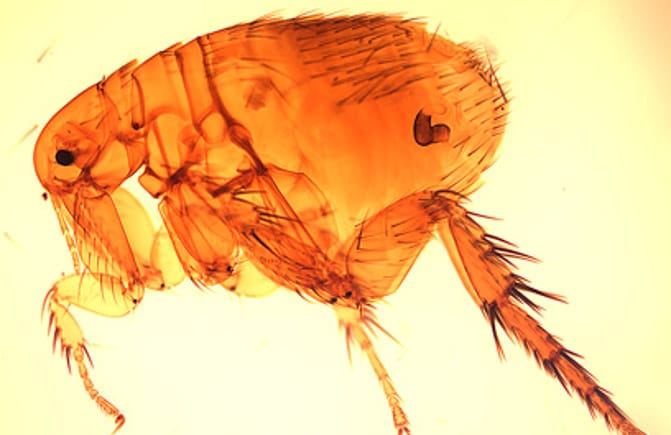Key points
- Murine typhus is caused by the bacteria Rickettsia typhi.
- People can get the disease through contact with infected fleas.
- Symptoms of murine typhus include fever, chills, headache, and rash.
- Avoid flea contact, keep pets flea-free, and protect against flea bites through insect repellents and proper hygiene.
What it is
Murine typhus is a disease caused by the bacteria Rickettsia typhi. Murine typhus is spread to people through contact with infected fleas, most commonly the Oriental rat flea (Xenopsylla cheopsis) and the cat flea (Ctenocephalides felis). Fleas become infected when they bite infected animals, such as rats, cats, or opossums. Once infected, the flea remains infected for the remainder of its life.
When an infected flea bites a person or animal, the bite breaks the skin, causing a wound. Fleas poop when they feed. This poop (also called flea dirt) contains the bacteria, which can be rubbed into the bite wound or other wounds and cause an infection. However, less than 5% of patients will recall a fleabite or flea exposure in the one to two weeks preceding illness. People can also breathe in infected flea dirt or rub it into their eyes. These bacteria do not spread from person to person.
Murine typhus occurs in many tropical, subtropical, and temperate climates around the world, including several countries in Southeast Asia, Africa, Central and South America, southern Europe, and the Middle East. In the United States, southern California, Hawaii, and southern Texas report most cases, although cases likely occur in other states. In the few states that report this disease, the number of reported cases has increased significantly since 2008, suggesting that murine typhus may be considered a re-emerging infectious disease in certain areas of the United States.
Murine typhus can also be called flea-borne typhus or endemic typhus.
Signs and symptoms
Symptoms of murine typhus begin within 3-14 days after contact with infected fleas or flea dirt. However, people often do not know they have been bitten by a flea or exposed to flea dirt. Risk factors include time spent outdoors or contact with particular animals, especially rats, opossums, or free-roaming cats.
Signs and symptoms of murine typhus can include:
- Fever and chills
- Body aches and muscle pain
- Headache
- Loss of appetite
- Nausea
- Vomiting
- Stomach pain
- Cough
- Rash (typically occurs in about half of patients, and generally begins around day 5 of illness)
Severe illness can occur in some people, but deaths are rare (estimated to be less than 1% of all cases). Almost all cases resolve completely with appropriate antibiotics. If the disease is not treated promptly, some people with the disease will need to be hospitalized. The disease can cause severe illness, including death, and can cause organ damage.

Prevention
There is no vaccine to prevent murine typhus. Reduce your risk of getting murine typhus by avoiding contact with fleas.
- Keep fleas off your pets.
- Animals that are allowed outside are more likely to bring fleas inside.
- Talk to your veterinarian about flea control products for pets, such as flea collars, oral medication, or topical flea prevention products.
- Permethrin should not be used on cats.
- Animals that are allowed outside are more likely to bring fleas inside.
- Keep rodents and wild animals (e.g., opossums) away from your home, workplace, and recreational areas.
- Store food, including pet food, in tightly sealed containers.
- Remove brush, rock piles, junk, and clutter outside of your home.
- Seal up holes in your home where rodents can enter.
- Keep lids closed on compost and trash cans to discourage animal visitors.
- The CDC's rodents website offers helpful suggestions on rodent control during and after a rodent infestation.
- Store food, including pet food, in tightly sealed containers.
- Protect yourself from flea bites.
- Do not feed or pet wild or stray animals.
- Always wear gloves if you are handling sick or dead animals.
- Use Environmental Protection Agency-registered insect repellents on your skin and clothing when spending time outside. Always follow instructions listed on the product label as some products are for skin and others are for clothing only.
- Do not feed or pet wild or stray animals.
Testing and diagnosis
- During the first week of illness, the signs and symptoms of murine typhus are similar to those of many other diseases. See your healthcare provider if you develop the symptoms listed above, and if appropriate, be sure to mention contact with fleas, domestic rodents (rats and mice), stray animals (such as cats), or wildlife (such as opossums).
- Your healthcare provider may order a blood test to look for the bacteria that cause murine typhus or other diseases, or to measure antibodies indicating recent exposure.
- Laboratory testing and reporting of results can take several weeks, so your healthcare provider may decide to start treatment before results are available.
Treatment and recovery
- Murine typhus is treated with the antibiotic doxycycline. Doxycycline can be used in people of all ages.
- Antibiotics are most effective when given soon after symptoms begin.
- People treated early with doxycycline usually recover quickly.
- There is no evidence that persistent or chronic infections occur.
Although usually a self-limited disease, treatment with doxycycline shortens the duration of illness. When not treated with appropriate antibiotics, fever can last up to 2–3 weeks and illness may become severe. The severity of symptoms varies widely, and murine typhus can be fatal in rare cases.
